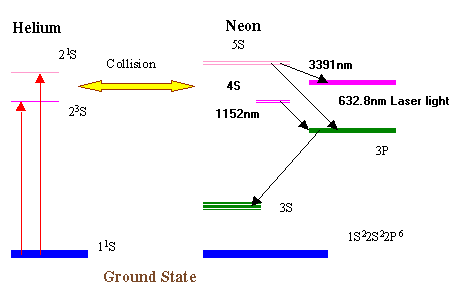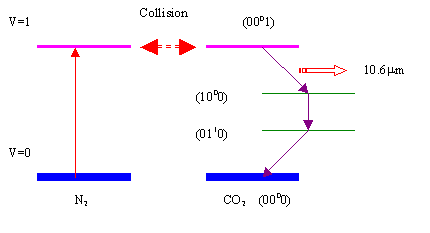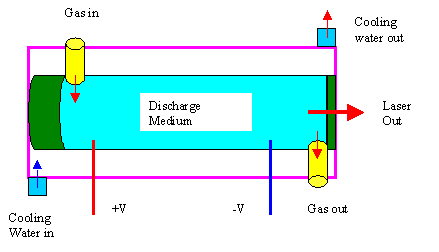Section 2.6: Common Industrial Lasers
Lasers can be divided into gas lasers, solid state lasers and liquid lasers according to the active medium used.
Gas Lasers:
Gas Lasers can be further divided into neutral atom, ion and molecular lasers, whose lasing mediums are neutral atoms, ions or gas molecules respectively.
Helium-neon (He-Ne) laser is a kind of neutral atom gas laser, the common wavelength of a He-Ne laser is 632.8 nm, it is tunable from infrared to various visible light frequencies. He and Ne are mixed according to certain percentage, pumping is by DC electrical discharge in the low pressure discharge tube. First He atom is excited. Because Ne atom has an energy level very near to an energy level of He, through kinetic interaction, energy is readily transferred from He to Ne, and Ne atom emit the desired laser light. The typical power of He-Ne laser is below 50 mW, it is widely used in holography, scanning, measurement, optical fiber communication, etc. It is the most popular visible light laser.

Figure 2.3: Scheme of energy levels of He-Ne laser
Carbon dioxide laser is a typical molecular gas laser, it emits laser light at a wavelength of 10.6 m m, its beam power ranges from several watts to 25 kW or even to 100 kW, so CO2 laser is widely used in laser machining, welding and surface treating. For this reason, let's investigate it in detail.
The active medium of CO2 laser is a mixture of CO2, helium and nitrogen gases, the approximate constitute is CO2:N2:He::0.8:1:7. Pumping is realized by AC or DC electrical discharge. First most of the electrical discharge energy is absorbed by nitrogen gas, only a small part of the energy is absorbed by CO2 molecules directly which raise them from ground state (000) to upper state (001). Large amounts of CO2 molecules collide with the nitrogen molecules and gain the excitation energy. Once excitation is achieved, the CO2 molecules at (001) state will give out energy and jump to lower energy state (100) or (020), thus giving out laser light at frequency 10.6m m or 9.6 m m respectively. The remaining decay from state (100) to (010), (020) to (010) or (010) to ground state (000) will dissipate energy in the form heat instead of light.

Figure 2.4: CO2 laser energy level
Helium gas has high thermal diffusivity, while the thermal diffusivity of CO2 is low. This combination makes CO2 gas to have high lasing efficiency compared with other lasing materials and in the same time, the system also has good thermal diffusivity. Thus the role of helium is evident. The cooling of the carbon dioxide gas mixture becomes very important for the stable operation of CO2 lasers, there are three basic cooling designs.
Slow Flow Lasers:
At too high temperatures, the lower energy levels of CO2 molecules inside the laser can not be emptied to ground level fast enough, population inversion condition might be disturbed, and lasing might stop. Thus the lasing action is limited by a upper temperature, Tlim. For slow flow lasers, cooling is through the walls of the cavity, typically gas flow is about 20 l/min, coolant flow is about 7 l/min at room temperature.

Figure 2.5: Cooling designs for CO2 lasers
The highest power gain per unit cavity length can be computed as:
P=4p h kL(Tlim-Tc)
Where h is the energy conversion efficiency from pumping to optical, typical value 0.12; k is the heat conductivity of He, 0.14W/mK at 0 degree; L is the length of cavity, Tlim is the highest lasing temperature, 250° C, Tc is the coolant temperature, typical value 10° C.
For the above values, P is around 50W/m, not very high. To reach a higher power, the cavity has to be very long.
Fast Axial Flow Lasers:
Such lasers use gas convection for cooling, gas flows at the speed of 300~500 m/s through the discharge zone, the flow, discharge and optical oscillation are all along the optical axis, which favors the symmetrical power distribution of the laser beam. The typical power gain is about ten times more than the slow flow lasers. The output power is also decided by the cooling efficiency.
Transverse Flow Lasers:
The axial convection cooling is good for symmetrical beam energy distribution, but the transverse flow design is more effective, thus compact high power lasers are designed in this way. The disadvantage is the lack of symmetry.
There are many other flow patterns, for example, using spiral flow around the cavity. Since the flow pattern has so close relation with the quality of lasers, this area is a big concern in laser design.
Solid State Lasers
In solid state lasers, ions are suspended in crystalline matrix to generate laser light. The ions emit electrons when excited, the crystalline matrix spread the energy among the ions. The first solid state laser is ruby laser, but it is no longer used because of its low efficiency. Two common solid state lasers are Nd:YAG lasers and Nd:glass lasers, there structures are very similar. Both use krypton or xenon flash lamps for optical pumping.
For Nd:glass lasers, the glass rod has the advantage of growing into larger size than YAG crystals, but the low thermal conductivity of glass limits the pulse repetition rate of Nd:glass laser. So Nd:glass lasers are used in applications which require high pulse energies and low pulse repetition rates. It is suitable for hole piercing and deep keyhole welding operations.
YAG crystal has a higher thermal conductivity than glass, so the thermal dissipation in Nd:YAG laser cavity can be improved, operation power can be up to several hundred watts in continuous mode, and high pulse rates (50kHz) can be reached. YAG is a complex crystal of Yttrium-Aluminium-Garnet with chemical composition of Y3Al5O12, it is transparent and colorless. About 1% Nd3+ ions are doped into the YAG crystal, the crystal color then changed to a light blue color. The wavelength of Nd:YAG laser is 1.06m m.
Solid state lasers are widely used in laser machining.
Note: the following is the construction of our Q-Switched Nd-YAG laser. For a common Nd:YAG laser, QWP, QS, GL-C, UV-C are not included. The signs in the picture are as follows. Circ:circuit board; RM:rear mirror; QWP:Quarter wavelength plate;QS:Quick switch;Ap/Sh:aperture and shutter;T-S:temperature test sensor; L-C,UV-C:green light crystal and UV light crystal; FM:front mirror.
Click on the figure to listen to a brief description on it.
Figure 2.6: Construction for our Q-Switched UV Nd-YAG laser
G 2.4 Audio: NdYAGLaser.wav
Liquid Lasers
Liquid Lasers use large organic dye molecules as the active lasing medium. These lasers can lase in a wide frequency range, i.e. they are frequency tunable. The spectral range of dyes covers infrared, visible and ultraviolet light. Pumping is by another pulsed/continuous laser, or by pulsed lamp. These lasers are used in spectroscopic investigation and photochemical experiments.
 Click
here to see the video: Lasers
in Our Lab(AVI format), Lasers in Our Lab(MPG
format).
Click
here to see the video: Lasers
in Our Lab(AVI format), Lasers in Our Lab(MPG
format).
For other lasers, such as excimer lasers and semiconductor lasers, please refer to Level 2 section 2.11 and 2.12